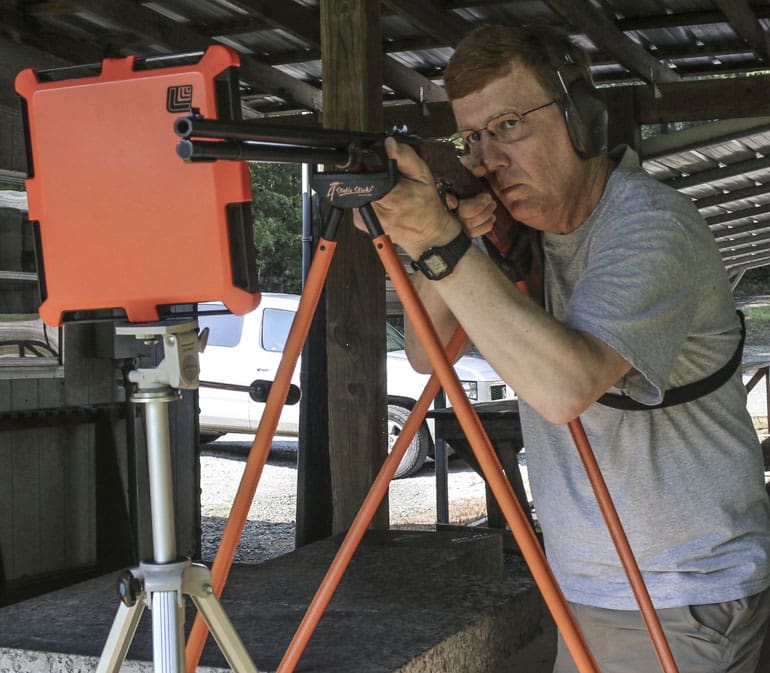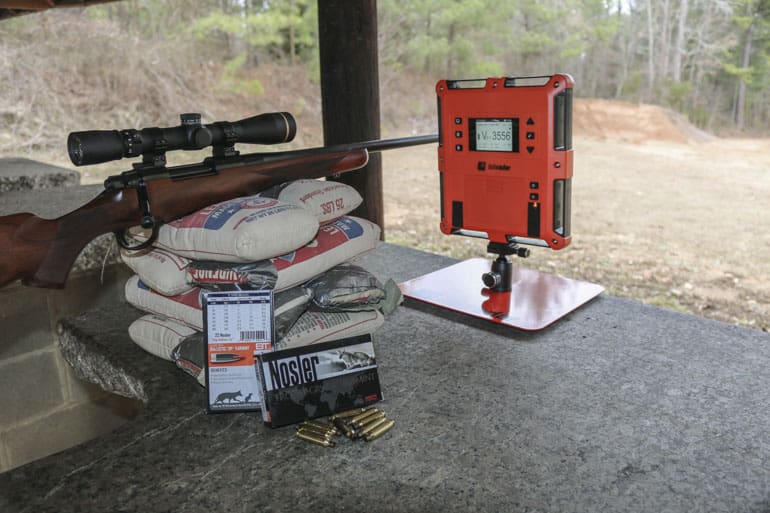In the 1950’s, scientists developed what we now refer to as ‘Doppler radar’. A more recent application of the Doppler-radar technology resulted in the chronograph, called Labradar (produced by Infinition Inc. of Trois-Rivieres, Quebec, Canada).
My own research into what chronograph to purchase began because of a series of reviews I was asked to do on various firearms. I expected to purchase a light-based product. This was the only type with which I was familiar, having used those belonging to friends. When I discovered Labradar I admit I was more skeptical than intrigued.
However, as I investigated the technology, I became convinced that this might be a revolutionary method for collecting measurements important for competitive shooters and hunters. The fact that this product gives accurate readings without being concerned about light conditions, or [sigh] accidentally shooting the chronograph, was exciting.

To date, I have used my Labradar unit to collect data from 12 rifles, 2 revolvers and 1 semi-automatic pistol. The setup takes only a few minutes for each range session.
I find the screen images easy to see and interpret; these include the date, time, velocity range (rifle, handgun or bow), battery power level, shot series number, shot number in the series, velocity units, distance units, radar strength, muzzle velocity and velocities at five distances from the muzzle/bow.
The information for each shot series, as downloaded from an SDHC card onto a computer, is contained in an Excel file and includes all of the above values for each shot fired, plus the lowest, highest and mean muzzle velocity (along with the standard deviation and spread from these values), the kinetic energy values at each distance and a power factor value (used by action shooters).
I have never found a light-based chronograph to be as straightforward or valuable (in terms of the variety of data collected) as I have my Labradar. After many range sessions with 15 firearms, I can state unequivocally that if my Labradar ever stops functioning, I will purchase a replacement!
Be warned. The Labradar isn’t inexpensive. It will run you about $560. But it’s worth every penny.





Orange is the new black
Labradar is now accepted as the best for non pros
Doppler is also less accurate than the other methods. But easier and more convenient. So one is making the choice between more expensive and convenient, or greater accuracy.
Usually that means the most accurate for a professional lab (who is after accuracy much more than ease of use), whatever the cost, and the easier choice for journalists and reviewers.
Can you either expand on your statement that its less accurate.
Less accurate than what? A 3 screen Ohler?? A standard consumer 2 screen model??
If it is less accurate than a consumer grade model, does the data center around the mean?
Note to readers who don’t understand this. In other words, if the actual MV of 4 shots is 1000 fps. And this gives a reading of 1020, 980, 990, 1010, its average will be 1000 fps.
Which means its average (mean) is the same as the actual. So as long as you average a string of shots, you will get correct date.
My understanding is just the opposite. I was told that the Labrador was the closest when compared to professional systems costing many thousands.
You have been misinformed. They advertise it as within 1fps of the 100,000+ dollar bullet factory equipment. I have actually confirmed it’s accuracy.
Not sure where you got the notion that Doppler is inaccurate, but there are now Doppler imagery that catch bullet wobble at super long distances. I have used my Labradar with a long distance rig, not only to shrink the extreme spread, but using Hornady’s 4DOF calculator with their loaded data and confirmed it to be at less than a fps deviant. Not only that we only used the Labradar at 200yds, reading 25, 50 100, 150, and 200. Then took rifle out into the wilderness and with that 100 yd dope, made a distance determination, set scope for height and spin drift, and it very consistently hit exactly where it should at just under 800yds. In fact, the person I had shoot the rifle made a nice 3″ group at that distance. If it was inaccurate, that wouldn’t happen…I know, cuz I have the other stuff as well.
Personally, I’m not sure how I got along without it for this long.
Doppler radar also gives you multiple points of data throughout the flight. You get one timing/distance with an optical chronograph, so you’d have to set up many along the flight path to match the capabilities. Institutions with hundreds of thousands to spend for research choose radar.
I would feel a lot better about this if strych9 would weigh-in. He knows everything.
“Things That Don’t Suck: Labradar Chronograph”
Usually, the more you spend, the less things suck…
I bought a LabRadar and have been using it primarily with 22LR. Is it perfect? No. You need to have it aimed very close to the center of the target, which isn’t easy given all they provide you is a V-notch at the top of the unit, in order for it to pickup most shots. I get a little above 80% on average with 22LR. With a larger caliber round such as 9mm, I get closer to 99%. You also need to pay attention to the SNR (signal to noise ratio) in the TRK (shot track) files as it’ll provide you some guidance on the reliability of the data provided.
Although the LabRadar isn’t supposed to pickup rounds that come in from a steep angle (i.e. shooters around you), I find that it pics up and records other shooters very often. So unless I’m the only one at the range, I usually skip using the Labradar.
It may sound as if I’m being negative about the LabRadar. In fact, I use it often and think it’s a great product. I just want to be sure that everyone reading this post has realistic expectations. Using the data from the LabRadar, weather data from a Kestrel, and JBM ballistics, I can calculate the BC (ballistic coefficient) for each shot in a series and average them to get a very accurate BC for each rifle/ammo combination. I find the calculated BC to be more accurate than numbers provided by the ammo manufacturers or online. A correct BC is invaluable when shooting 22LR ELR (extreme long range). A light based chronograph wouldn’t work as you need 2 speed values per shot with a reasonable separation between them in order to calculate the BC.
A few things that might help: In order to aim the unit better, hold (or tape) a straw in the v-notch of the unit. It’s much easier to visually aim that way. If you are going to use it with a slower bullet like a 22LR (even out of a 22LR rifle), be sure to set the LabRadar to pistol rather than rifle. Mine wouldn’t even pickup a 22LR round until I made that change even when using the optional external mic. I use 4 rechargeable AA batteries in my Labradar. But I also use an external battery pack. It’ll run off the battery pack and use the internal AA batteries like a backup.
Straw or a bic pen tube – great idea. ill try that
What about gluing or screwing something like this to the unit. Or a cheap red dot??
https://seeallopensight.com/collections/under-100
Its nice but very tricky as you must have distance for the doppler to work. It must be aimed well at the target. Once you understand how it works it is very nice. For me the big disappointment is it will not work at my local indoor range. It may be all the sound absorbing materials on walls and ceilings. It’s hot in Florida so that does suck.
Maybe a new ..often…not every day.. column “with the Title “Things that don’t suck.”
Cover all kinds of things..but short like this one.
I like the idea anyway.
I do too. That’s a good idea.
If you can justify $560 for a chronograph, I say more power to you.
Personally, I will limp along with my $80 (sale price) light-based (traditional) chronograph. It seems to be accurate enough for what I need to do, which is ensure that my .44 Magnum rifles are accurate to 150 yards (which requires accounting for considerable bullet drop over that distance).
Me and another member convinced our club BOD to buy 1 of these to replace our ageing Ohler that had a short in it and the keys would not always work. Best $600 they ever spent. Only drawback is it will tell you things you did not want to know. Like an ES of 100 on a service rifle load, made on a Dillon. Yikes!
Comments are closed.